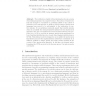Free Online Productivity Tools
i2Speak
i2Symbol
i2OCR
iTex2Img
iWeb2Print
iWeb2Shot
i2Type
iPdf2Split
iPdf2Merge
i2Bopomofo
i2Arabic
i2Style
i2Image
i2PDF
iLatex2Rtf
Sci2ools
ICFEM
2003
Springer
2003
Springer
Formal Proof of a Polychronous Protocol for Loosely Time-Triggered Architectures
The verification of safety critical systems has become an area of increasing importance in computer science. The notion of reactive system has emerged to concentrate on problems related to the control of interaction and response-time in mission-critical systems. Synchronous languages have proved to be well-adapted to the verification of reactive systems. It is nonetheless commonly argued that real-life systems often do not satisfy the strong hypotheses assumed by the synchronous approach: they are not synchronous. Protocols have however been pro.g. in [1]) to provide an abstract synchronous specification on top of real-time architectures (e.g. loosely time-triggered architectures or his abstract model is designed so as to satisfy the synchronous hypotheses and meet the implementation architecture constraints. It is makes it possible to design, specify and verify reactive systems in the context of the synchronous approach. In this aim, the present article formalizes the LTTA protocol...
| Added | 06 Jul 2010 |
| Updated | 06 Jul 2010 |
| Type | Conference |
| Year | 2003 |
| Where | ICFEM |
| Authors | Mickaël Kerboeuf, David Nowak, Jean-Pierre Talpin |
Comments (0)

